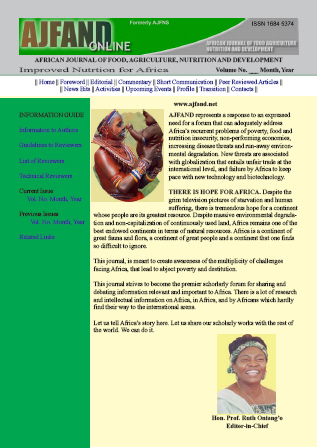
|
African Journal of Food, Agriculture, Nutrition and Development
Rural Outreach Program
ISSN: 1684-5358
EISSN: 1684-5358
Vol. 10, No. 5, 2010, pp. 2515-2541
|
 Bioline Code: nd10047
Bioline Code: nd10047
Full paper language: English
Document type: Research Article
Document available free of charge
|
|
|
African Journal of Food, Agriculture, Nutrition and Development, Vol. 10, No. 5, 2010, pp. 2515-2541
| en |
Agricultural lending decision: A tobit regression analysis
Olagunju, F.I. & Ajiboye, A.
Abstract
Using data from a survey of loan applicants and bank officials from Union Bank of Nigeria and First Bank of Nigeria in south-western Nigeria, this paper empirically evaluated the determinants of loan approval decision and the size of the loan given using a Tobit regression model. With a multi-stage sampling technique, data were collected with the aid of structured questionnaire drawn on 450 applicants. The respondents′ ages varied between twenty five years and sixty nine years with a mean of fifty and a half years for all the respondents. The mean age recorded for each category of respondents suggests that middle-aged farmers who are expected to be economically active and energetic dominated the sampled population. They should be willing to explore avenues and adopt new methods in order to raise their level of productivity. The relatively large farm sizes owned by the applicants indicated that it is one of the major criteria for giving loans to the farmers; hence those with very small farm sizes may not have access to loans from the two institutions. Tobit estimates show that institutional, environmental and part of the resource variables were important determinant factors of loan approval decision and a decomposition of elasticities calculated at the mean of the variables revealed that a 10% increase in the RISK variable will lead to a total elasticity change of about -0.79 %. This indicates that the elasticity of probability of loan approval will decrease by about 0.36 % and elasticity of expected loan size will decrease by 0.43%. The result tends to imply risk- averseness of the lenders, as fewer loans are granted. The positive coefficient of HHZE indicated that high farm assistance was received from respondents′ relations who positively influenced the implications for family labour and cultivation of large area of land and eventually influenced the approval decision. The coefficient of NFI positively influenced the loan approval decision since the farmer can expand his options to acquire more loans and use for profitable ventures since this variable is viewed as a proxy for wealth, thus the beneficiary will have sufficient resources to absorb the cost and risk of failure in their agricultural enterprises. In each of the two institutions, the marginal changes in most of the variables considered increased the probability of loan size influence than it increased the probability of approval.
Keywords
Lending Decision, Tobit Regression, Credit
|
| |
© Copyright 2010 African Journal of Food Agriculture, Nutrition and Development.
Alternative site location: http://www.ajfand.net/
|
|
